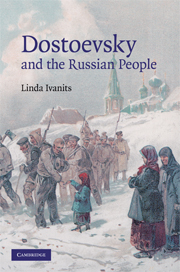Book contents
- Frontmatter
- Contents
- Acknowledgments
- Note on transliteration
- Introduction: the people in Dostoevsky's art and thought
- 1 The face of the people, 1821–1865
- 2 The world of the people in Crime and Punishment
- 3 The Idiot: where have all the people gone?
- 4 Fumbling toward Holy Russia in The Devils
- 5 Back in Russia: the face of the people, 1871–1877
- 6 The Brothers Karamazov: Christ walks the Russian land
- Concluding remarks: Dostoevsky and the people
- Notes
- Bibliography
- Index
3 - The Idiot: where have all the people gone?
Published online by Cambridge University Press: 22 September 2009
- Frontmatter
- Contents
- Acknowledgments
- Note on transliteration
- Introduction: the people in Dostoevsky's art and thought
- 1 The face of the people, 1821–1865
- 2 The world of the people in Crime and Punishment
- 3 The Idiot: where have all the people gone?
- 4 Fumbling toward Holy Russia in The Devils
- 5 Back in Russia: the face of the people, 1871–1877
- 6 The Brothers Karamazov: Christ walks the Russian land
- Concluding remarks: Dostoevsky and the people
- Notes
- Bibliography
- Index
Summary
At the end of Crime and Punishment, Raskolnikov stands on the threshold of new life. His heart has at last softened and he is able to love Sonia. The Idiot concludes on a far darker note. Prince Myshkin appears before us for the final time in a stupor near the murdered body of Nastasia Filippovna. Dostoevsky wrote his new novel in western Europe, but, like Crime and Punishment, it is set in Petersburg. While the action of the earlier work occurs in the seamy neighborhood of Haymarket Square, The Idiot takes place largely in the well-to-do environs of Liteiny Prospect and in the elegant summer homes and park of suburban Pavlovsk. The moneyed milieu of post-Reform Russia with its schemes for amassing capital has replaced that of impoverished slum dwellers. In The Idiot one finds the familiar discussions of Christian morality interwoven with arguments by the political left, and this novel is also built around a single hero who appears in almost every scene. But Raskolnikov is one of Dostoevsky's “great sinners” whose story unfolds along the pattern of a quest for self-understanding and anticipates inner transformation. Prince Myshkin, by contrast, appears in the novel almost fully developed, his portrayal turning on implications that he is Christ-like. His story follows not a linear pattern of development and change, but a circular one of emergence from and return to a state of idiocy.
The central problem of The Idiot is its gloomy religious atmosphere.
- Type
- Chapter
- Information
- Dostoevsky and the Russian People , pp. 77 - 105Publisher: Cambridge University PressPrint publication year: 2008



